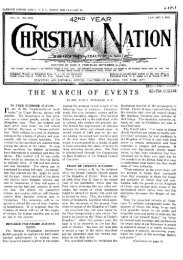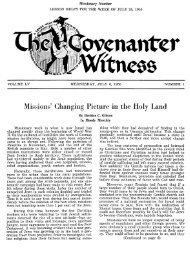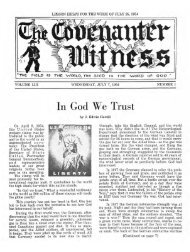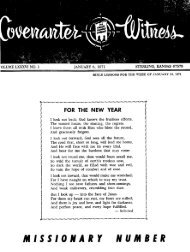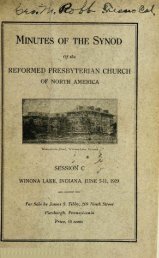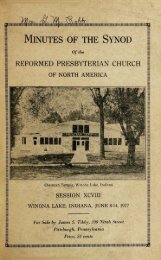Covenanter Witness Vol. 54 - Rparchives.org
Covenanter Witness Vol. 54 - Rparchives.org
Covenanter Witness Vol. 54 - Rparchives.org
Create successful ePaper yourself
Turn your PDF publications into a flip-book with our unique Google optimized e-Paper software.
welfare"<br />
Current Events<br />
By Prof. William H. Russell, Ph.D.<br />
TAKING A STAND<br />
Crucial decisions are now being made on our involve<br />
ment in the defense of the Nationalist government of China.<br />
The Communist campaign against the Nationalist-held is<br />
lands off the coast has been stepped up sharply, and the<br />
northernmost island has already been captured. The Tachen<br />
group is under immediate threat of invasion. These islands<br />
have been heavily bombarded and U. S. observers have been<br />
withdrawn, but the Nationalists refuse to surrender. Presi<br />
dent Eisenhower has replied to the Communist campaign by<br />
asking Congress for authority to defend Formosa and its<br />
nearby islands. He has also bolstered the Seventh Fleet<br />
which patrols the waters between Formosa and the main<br />
land. U. S. warships may be used to evacuate civilians from<br />
the Tachen islands. If our ships should also undertake the<br />
transportation of Nationalist troops, the Communists would<br />
be likely to open fire, and another war might be started. We<br />
hope the outlook will be more encouraging later.<br />
CEASE FIRE<br />
President Eisenhower and Secretary of State Dulles<br />
have stated that they will not make any concessions to Red<br />
China, but they would be willing for the U. N. Security<br />
Council to arrange a settlement. Anthony Eden of Great<br />
Britain has also been trying for a cease-fire, perhaps based<br />
on the idea that the Nationalists would give up the Tachen<br />
islands in return for recognition of their right to Formosa<br />
and the Pescadores. However, Peiping<br />
claims that all this<br />
territory is rightfully hers, and objects to any U. N. action<br />
as interference with her "domestic" affairs. The Tachens<br />
are hardly essential to the defense of Formosa, as the Reds<br />
already have mainland bases closer to the Nationalist head<br />
quarters. The Communist conquest must be stopped some<br />
where, though, and the question is whether we can keep<br />
them out of the Tachen islands without a major war. Red<br />
China's policy seems just like a man trying to see how far he<br />
can lean over a cliff without falling.<br />
BILLIONS TO SPEND<br />
The budget President Eisenhower has submitted to Con<br />
gress calls for an outlay of $62.4 billion in the next fiscal<br />
year. With revenues expected to reach $60 billion, there will<br />
be a deficit of $2.4 billion. This will be the smallest deficit<br />
in several years, but the Administration will again have to<br />
ask Congress to raise the debt ceiling from its present level<br />
of $275 billion. Our progress toward a balanced budget is<br />
certainly slow. One hopeful sign is that in recent years the<br />
national debt has not increased as fast as the population or<br />
the national wealth. For example, in 1945 the national debt<br />
was over one and a quarter times the gross national product,<br />
but in 19<strong>54</strong> it was only about three-quarters as great as our<br />
total production.<br />
$34 billion, or over half of the new budget, is earmarked<br />
for defense. The Air Force leads with $15.6 billion, represent<br />
ing an increase, while the Navy and Army<br />
Foreign aid is scheduled for $4.7 billion if Congress ap<br />
are cut somewhat.<br />
proves, and atomic energy for $2 billion. The total for na<br />
tional security will thus reach about 65 per cent of the bud<br />
get. Other fixed charges such as benefits veterans'<br />
and in<br />
terest on the debt amount to another 24 per cent. This leaves<br />
a rather small margin for the "general<br />
February 2, 1955<br />
services<br />
which have been the usual target of those who advocate<br />
retrenchment.<br />
BUSINESS BACKS THE COLLEGES<br />
About half the private colleges and universities of this<br />
country run at a deficit, and nearly all are falling behind<br />
in plant construction. But their acute financial problems<br />
have led to an impressive movement of support from big<br />
business. President Harlow H. Curtice of General Motors<br />
recently announced a very broad and generous program..<br />
His company already spends about $2.5 million a year on<br />
various forms of educational aid, but is now adding $2<br />
million more. Much of this will consist of four-year scholar<br />
ships. Each scholarship will carry an additional grant of<br />
$500 to $800 to the institution, in recognition of the fact that<br />
tuition does not meet the full costs of education. There will<br />
also be gifts to regional foundations representing small<br />
colleges. A total of 306 campuses will benefit from the Gen<br />
eral Motors plan.<br />
President Curtice called the program a practical ven<br />
ture, since industry benefits by the improved training of its<br />
workers. Several other large companies, such as Ford, Du<br />
Pont, General Electric, U. S. Steel, and Standard Oil, also<br />
give very large amounts to educational institutions every<br />
year. They prefer to support higher education themselves<br />
rather than see it fall entirely into the hands of the govern<br />
ment<br />
in which case they would still support it, by taxation.<br />
The business grants tend to favor scientific studies, but<br />
they free institutional resources for other fields, so that<br />
with wise direction a balanced program can still be main<br />
tained.<br />
POLIO FUND<br />
The annual March of Dimes again calls attention to<br />
the cost of care and research in infantile paralysis. The<br />
National Foundation is spending $7.5 million on an ex<br />
haustive evaluation of the Salk polio vaccine given last year.<br />
Twenty-seven laboratories are now performing delicate tests<br />
on blood samples from 40,000 children to determine the<br />
vaccine's effects. The health records of a million and a half<br />
children must also be compared to determine whether those<br />
receiving the vaccine had a significantly lower polio rate.<br />
The evaluation will not be complete until late spring, but the<br />
National Foundation has taken the chance of ordering $9,<br />
million worth of the vaccine for use next season.<br />
PRISON BREAK<br />
Most Americans prefer not to worry about the treat<br />
ment given the men in our prisons; but the issue is raised<br />
again by four desperate convicts who withstood a<br />
three-day<br />
siege before surrendering at the Massachusetts State Prison<br />
at Charlestown. A seven-man committee chosen by the<br />
prisoners finally persuaded them to surrender. They thus<br />
faced the certainty of heavy additional sentences in order to<br />
call attention to their plight. The prison is 150 years old and<br />
fantastically over-crowded. The long sentences given in<br />
Massachusetts also made their situation more hopeless.<br />
Americans need to do some serious<br />
thinking about the pur<br />
pose of our penal institutions. Prison terms should not be<br />
based on a desire for vengeance, and the prisoners should<br />
be guaranteed some human rights. Most states do not<br />
(Continued on page 68)<br />
67



